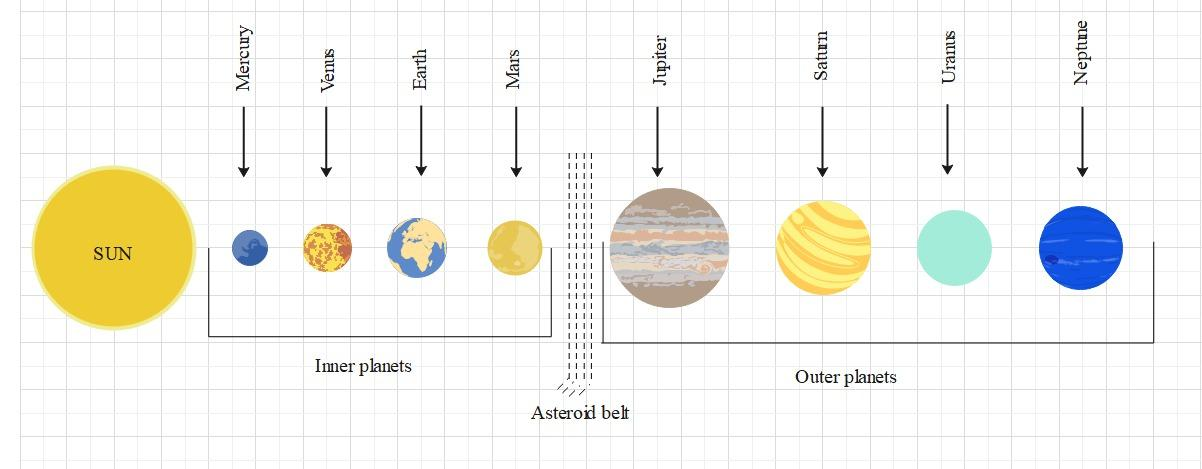
What is the solar system? Write the names of planets of the solar system in sequence.
Answer
577.8k+ views
Hint: The term solar means it has to do something with the Sun. The Sun is a star just like other stars you see in the night sky. Eight planets including our Earth revolve around the Sun along with their moons.
Complete step by step answer:

As we live with our family, our planet Earth also has a family. As we have our parents and siblings in our family. The Earth has Sun and other planets in his family. The family of the Earth is known as the solar system.
A solar system is a collection of the Sun, eight planets and their moons, comets, asteroids, meteoroids, and dwarf planets revolving around the Sun. The eight planets revolving around the Sun in a sequence are Mercury, Venus, Earth, Mars, Jupiter, Saturn, Uranus, and Neptune. There is an asteroid belt between Mars and Jupiter. These planets revolve around the Sun in an elliptical orbit. There are other astronomical objects too in our solar systems such as meteoroids, comets, and a dwarf planet. Pluto is a dwarf planet. Earlier it was considered as a planet but then it was discarded because it doesn’t satisfy the criteria of planets.
The solar system is 286.47 billion km wide!! The fastest man made object will take approximately 6759 years to reach the edge of our solar system. The sizes of the planets and the Sun are also very huge. The Sun itself is so huge that it contains more than 99% of the total mass in our solar system. The radius of the Earth is 6400km whereas the radius of the Sun is 696,340 km. The Sun is so big that 100 piles of earth can fit along its radius. Jupiter is the biggest planet among all the planets whereas mercury is the smallest planet.
To imagine the relative sizes, imagine that if the Sun is as big as the door then Earth would be the size of the nail on it. If Jupiter is as big as a football then the Earth would be the size of a grape in front of it.
Note:
There are many star systems in the universe. The family of these solar systems along with interstellar dust is known as a galaxy. The collection of galaxies is known as a cluster. There are millions of billion solar systems and over a billion galaxies in the universe. In this vast universe, the Earth is the only planet that has life as we know so far.
Complete step by step answer:

As we live with our family, our planet Earth also has a family. As we have our parents and siblings in our family. The Earth has Sun and other planets in his family. The family of the Earth is known as the solar system.
A solar system is a collection of the Sun, eight planets and their moons, comets, asteroids, meteoroids, and dwarf planets revolving around the Sun. The eight planets revolving around the Sun in a sequence are Mercury, Venus, Earth, Mars, Jupiter, Saturn, Uranus, and Neptune. There is an asteroid belt between Mars and Jupiter. These planets revolve around the Sun in an elliptical orbit. There are other astronomical objects too in our solar systems such as meteoroids, comets, and a dwarf planet. Pluto is a dwarf planet. Earlier it was considered as a planet but then it was discarded because it doesn’t satisfy the criteria of planets.
The solar system is 286.47 billion km wide!! The fastest man made object will take approximately 6759 years to reach the edge of our solar system. The sizes of the planets and the Sun are also very huge. The Sun itself is so huge that it contains more than 99% of the total mass in our solar system. The radius of the Earth is 6400km whereas the radius of the Sun is 696,340 km. The Sun is so big that 100 piles of earth can fit along its radius. Jupiter is the biggest planet among all the planets whereas mercury is the smallest planet.
To imagine the relative sizes, imagine that if the Sun is as big as the door then Earth would be the size of the nail on it. If Jupiter is as big as a football then the Earth would be the size of a grape in front of it.
Note:
There are many star systems in the universe. The family of these solar systems along with interstellar dust is known as a galaxy. The collection of galaxies is known as a cluster. There are millions of billion solar systems and over a billion galaxies in the universe. In this vast universe, the Earth is the only planet that has life as we know so far.
Recently Updated Pages
Master Class 12 Business Studies: Engaging Questions & Answers for Success

Master Class 12 Economics: Engaging Questions & Answers for Success

Master Class 12 English: Engaging Questions & Answers for Success

Master Class 12 Maths: Engaging Questions & Answers for Success

Master Class 12 Social Science: Engaging Questions & Answers for Success

Master Class 12 Chemistry: Engaging Questions & Answers for Success

Trending doubts
Full Form of IASDMIPSIFSIRSPOLICE class 7 social science CBSE

Convert 200 Million dollars in rupees class 7 maths CBSE

What are the controls affecting the climate of Ind class 7 social science CBSE

List of coprime numbers from 1 to 100 class 7 maths CBSE

Write a letter to the editor of the national daily class 7 english CBSE

Fill in the blanks with appropriate modals a Drivers class 7 english CBSE





